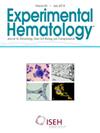Unbiased analysis of NUP98-KDM5A-induced murine leukemia reveals phenotypic heterogeneity recapitulating human disease subtypes
IF 2.1
4区 医学
Q2 HEMATOLOGY
引用次数: 0
Abstract
NUP98-KDM5A (NK5) is an oncogenic fusion protein implicated in the development of several types of acute myeloid leukemia (AML) in humans, including rare pediatric acute megakaryoblastic leukemia (AMKL). NK5 expression in murine hematopoietic progenitor cells can induce AML in mice. However, the limited number of animals and phenotypic markers used in previous studies preclude the full characterization of the AML subtypes that develop. We used NK5-transduced hematopoietic progenitor cells from murine fetal liver to generate a large cohort of mice. We then assessed the expression of a panel of myeloid markers to characterize the lineage of leukemic blasts using flow cytometry. Finally, we used bioinformatic tools to perform an unbiased analysis of mouse-to-mouse heterogeneity in leukemic cellular phenotypes. We identified phenotypically distinct subgroups among the NK5 leukemias that were predominantly segregated based on the expression of the AMKL-associated marker CD41. Our findings indicate that NK5 expression in fetal liver cells causes different types of leukemia similar in proportion to that observed in pediatric patients. The heterogeneity and mixed phenotypes observed might explain the difficulty in accurately diagnosing leukemia in some patients carrying the NK5 fusion. In addition, this approach may enable the identification of the molecular or cellular basis of the diverse NK5-driven AML types.
对nup98 - kdm5a诱导的小鼠白血病的无偏分析揭示了再现人类疾病亚型的表型异质性。
NUP98-KDM5A (NK5)是一种致癌融合蛋白,与几种人类急性髓性白血病(AML)的发展有关,包括罕见的儿童急性巨核母细胞白血病(AMKL)。小鼠造血祖细胞表达NK5可诱导小鼠急性髓细胞白血病。然而,在以前的研究中使用的有限的动物数量和表型标记物阻碍了对发展的AML亚型的全面表征。我们使用来自小鼠胎肝的nk5转导的造血祖细胞来产生大的小鼠队列。然后,我们用流式细胞术评估了一组髓系标志物的表达,以表征白血病母细胞的谱系。最后,我们使用生物信息学工具对白血病细胞表型的小鼠间异质性进行了无偏分析。我们在NK5白血病中发现了表型上不同的亚群,这些亚群主要基于amkl相关标记CD41的表达而分离。我们的研究结果表明,NK5在胎儿肝细胞中的表达导致不同类型的白血病,其比例与在儿科患者中观察到的相似。观察到的异质性和混合表型可能解释了一些携带NK5融合的患者难以准确诊断白血病的原因。此外,这种方法可以鉴定不同的nk5驱动的AML类型的分子或细胞基础。
本文章由计算机程序翻译,如有差异,请以英文原文为准。
求助全文
约1分钟内获得全文
求助全文
来源期刊

Experimental hematology
医学-血液学
CiteScore
5.30
自引率
0.00%
发文量
84
审稿时长
58 days
期刊介绍:
Experimental Hematology publishes new findings, methodologies, reviews and perspectives in all areas of hematology and immune cell formation on a monthly basis that may include Special Issues on particular topics of current interest. The overall goal is to report new insights into how normal blood cells are produced, how their production is normally regulated, mechanisms that contribute to hematological diseases and new approaches to their treatment. Specific topics may include relevant developmental and aging processes, stem cell biology, analyses of intrinsic and extrinsic regulatory mechanisms, in vitro behavior of primary cells, clonal tracking, molecular and omics analyses, metabolism, epigenetics, bioengineering approaches, studies in model organisms, novel clinical observations, transplantation biology and new therapeutic avenues.
 求助内容:
求助内容: 应助结果提醒方式:
应助结果提醒方式:


